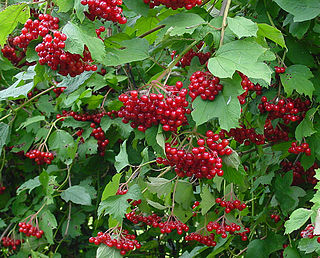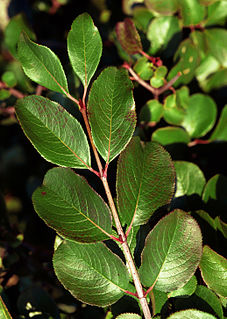
Viburnum is a genus of about 150–175 species of flowering plants in the moschatel family Adoxaceae. Its current classification is based on molecular phylogeny. It was previously included in the honeysuckle family Caprifoliaceae.

The crestless curassow is a species of bird in the family Cracidae. It is found in Brazil, Colombia, Guyana, and Venezuela. Its natural habitat is subtropical or tropical moist lowland forest.

Calophyllum tomentosum is a species of flowering plant in the family Calophyllaceae, commonly known as bintangur. It is found in Sri Lanka and the Western Ghats.
Antirhea tomentosa is a species of plant in the family Rubiaceae. It is endemic to Jamaica. It is threatened by habitat loss. The species was first discovered in 1780 and rediscovered in 1975, making it a Lazarus taxon.
Astronidium tomentosum is a species of plant in the family Melastomataceae. It is endemic to Fiji.
Glochidion tomentosum is a species of plant in the family Phyllanthaceae. It is native to Karnataka and Tamil Nadu in India.
Trichilia stellato-tomentosa is a species of plant in the family Meliaceae. It is found in Argentina, Bolivia, Brazil, and Paraguay.
Viburnum arboreum is a species of plant in the Adoxaceae family. It is endemic to Jamaica.

Viburnum costaricanum is a species of plant in the Adoxaceae family. It is found in Costa Rica and Panama. It is threatened by habitat loss.
Viburnum divaricatum is a species of plant in the Adoxaceae family. It is endemic to Ecuador. Its natural habitat is subtropical or tropical moist montane forests. It is threatened by habitat loss.
Viburnum hondurense is a species of plant in the Adoxaceae family. It is endemic to Honduras.

Viburnum maculatum is a species of plant in the family Adoxaceae. It is found in Montenegro on Lovćen and Orjen mountains, as well as in parts of Bosnia and Herzegovina. This plant is a xerophyte, and grows on karst mountain terrains.
Viburnum molinae is a species of plant in the Adoxaceae family. It is endemic to Honduras.
Viburnum mortonianum is a species of plant in the Adoxaceae family. It is found in El Salvador and Guatemala.
Viburnum subpubescens is a species of plant in the Adoxaceae family. It is endemic to Honduras.
Viburnum tridentatum is a species of plant in the Adoxaceae family. It is endemic to Peru.

Viburnum plicatum is a species of flowering plant in the family Adoxaceae, native to mainland China, Korea, Japan, and Taiwan. The Latin specific epithet plicatum means “pleated”, referring to the texture of the leaves.

Viburnum nudum is a deciduous shrub in the genus Viburnum within the muskroot family, Adoxaceae.

Viburnum rufidulum, also known as the rusty blackhaw, blue haw, rusty nanny-berry, or southern black haw, is a flowering species of shrub or small tree that is common in parts of the Eastern and Central United States. It produces attractive flowers and fall foliage, as well as fruits that are popular with some species of bird.
Zanthoxylum dipetalum is a rare species of tree in the family Rutaceae and in the same genus as Szechuan pepper. It is known by the Hawaiian names Kāwa'u and Heaʻe and is endemic to the Hawaiian archipelago, where it grows in forests on 3 or 4 of the islands.









